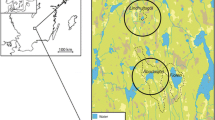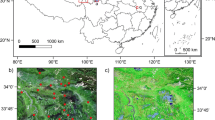Abstract
Information on the spatial distribution of past vegetation on local, regional and global scales is increasingly used within climate modelling, nature conservancy and archaeology. It is possible to obtain such information from fossil pollen records in lakes and bogs using the landscape reconstruction algorithm (LRA) and its two models, REVEALS and LOVE. These models assume that reliable pollen productivity estimates (PPEs) are available for the plant taxa involved in the quantitative reconstructions of past vegetation, and that PPEs are constant through time. This paper presents and discusses the PPEs for 15 tree and 18 herb taxa obtained in nine study areas of Europe. Observed differences in PPEs between regions may be explained by methodological issues and environmental variables, of which climate and related factors such as reproduction strategies and growth forms appear to be the most important. An evaluation of the PPEs at hand so far suggests that they can be used in modelling applications and quantitative reconstructions of past vegetation, provided that consideration of past environmental variability within the region is used to inform selection of PPEs, and bearing in mind that PPEs might have changed through time as a response to climate change. Application of a range of possible PPEs will allow a better evaluation of the results.






Similar content being viewed by others
References
Andersen ST (1970) The relative pollen productivity and representation of north European trees, and correction factors for tree pollen spectra. Danmarks Geologiske Undersøgelse Række II 96:1–99
Anderson NJ, Bugmann H, Dearing JA, Gaillard MJ (2006) Linking palaeoenvironmental data and models to understand the past and to predict the future. Trends Ecol Evolut 21:696–704
Autio J, Hicks S (2004) Annual variations in pollen deposition and meteorological conditions on the fell Aakenustunturi in northern Finland: potential for using fossil pollen as a climate proxy. Grana 43:31–47
Bradshaw R (2007) Detecting human impact in the pollen record using data-model comparison. Veget Hist Archaeobot. doi:10.1007/s00334-007-0116-8
Berglund BE, Gaillard MJ, Björkman L, Persson T (2007) Long-term changes in floristic diversity in southern Sweden—palynological richness, vegetation dynamics and land-use. Veget Hist Archaeobot. doi:10.1007/s00334-007-0094-x
Broström A (2002) Estimating source area of pollen and polen productivity in cultural landscapes of southern Sweden—developing a palynological tool for quantifying past plant cover. Doctoral thesis, Lund University, Lund
Broström A, Gaillard MJ, Ihse M, Odgaard B (1998) Pollen–landscape relationships in modern analogues of ancient cultural landscapes in southern Sweden—a first step towards quantification of vegetation openness in the past. Veget Hist Archaeobot 7:189–201
Broström A, Sugita S, Gaillard MJ (2004) Pollen productivity estimates for reconstruction of past vegetation cover in the cultural landscape of southern Sweden. Holocene 14:371–384
Broström A, Sugita S, Gaillard MJ, Pilesjö P (2005) Estimating spatial scale of pollen dispersal in the cultural landscape of southern Sweden. Holocene 15:252–262
Bunting MJ, Hjelle KL (2008) Effect of vegetation data collection strategies on estimates of relevant source area of pollen (RSAP) and relative pollen productivity (RPP) for non-arboreal taxa (submitted)
Bunting MJ, Gaillard MJ, Sugita S, Middleton R, Broström A (2004) Vegetation structure and pollen source area. Holocene 14:651–660
Bunting MJ, Armitage R, Binney HA, Waller M (2005) Estimates of “relative pollen productivity” and “relevant source area of pollen” for major tree taxa in two Norfolk (UK) woodlands. Holocene 15:459–465
Calcote R (1995) Pollen source area and pollen productivity: evidence from forest hollows. J Ecol 83:591–602
Caseldine C, Fyfe R (2006) A modelling approach to locating and characterising elm decline/landnam landscapes. Quat Sci Rev 25:632–644
Caseldine C, Fyfe R, Langdon C, Thompson G (2007a) Simulating the nature of vegetation communities at the opening of the Neolithic on Achill Island, Co. Mayo, Ireland—the potential role of models of pollen dispersal and deposition. Rev Palaeobot Palynol 144:135–144
Caseldine C, Fyfe R, Hjelle K (2007b) Pollen modelling, palaeoecology and archaeology—virtualisation and/or visualisation of the past? Veget Hist Archaeobot. doi:10.1007/s00334-007-0093-y
Dahlström A (2006) Grazing dynamics at different spatial and temporal scales: examples from the Swedish historical record A.D. 1620–1850. Veget Hist Archaeobot. doi:10.1007/s00334-006-0087-1
Davis MB (1963) On the theory of pollen analysis. Am J Sci 261:897–912
Duffin KI, Bunting MJ (2007) Relative pollen productivity and fall speed estimates for southern African savanna taxa. Veget Hist Archaeobot. doi:10.1007/s00334-007-0101-2
Eisenhut G (1961) Untersuchungen über die Morphologie und Ökologie der Pollenkörner heimischer und fremdländischer Waldbäume (English tr. by Jackson ST, Jaumann P 1989). Parey, Hamburg
Fyfe R (2006) GIS and the application of a model of pollen deposition and dispersal: a new approach to testing landscape hypotheses using the POLLANDCAL models. J Arch Sci 33:483–493
Gaillard MJ (2000) Development of the cultural landscape. In: Sandgren P (ed) Environmental changes in Fennoscandia during the Late Quaternary. LUNDQUA Report 37, Lund, pp 69–82
Gaillard MJ (2007) Pollen methods and studies—archaeological applications. In: Elias SA (ed) Encyclopedia of quaternary science, vol 3. Elsevier, Amsterdam, pp 2575–2595
Gaillard MJ, Birks HJB, Ihse M, Runborg S (1998) Pollen/landscape calibration based on modern pollen assemblages from surface-sediment samples and landscape mapping—a pilot study in south Sweden. In: Gaillard MJ, Berglund BE, Frenzel B, Huckriede U (eds) Quantification of land surface cleared of forest during the Holocene. (Paläoklimaforschung/Palaeoclimate Research 27) Fischer, Stuttgart, pp 31–52
Gaillard M-J, Sugita S, Bunting MJ, Middleton D, Hicks S, Broström A., Caseldine C, Giesecke T, Hjelle K, Langdon C, Nielsen A-B, Poska A, von Stedingk H, Veski S, and POLLANDCAL members* (2008) The use of simulation models in reconstructing past landscapes from fossil pollen data—research strategy and results from the POLLANDCAL network. Veget Hist Archaeobot
Gallandat JD, Gillet F, Havlicek E, Perrenoud A (1995) Typologie et systématique phyto-écologique des pâturages boisés du Jura suisse. Institut de botanique, Université de Neuchâtel
Gobat JM, Duckert O, Gallandat JD (1989) Quelques relations “microtopographie-sols-végétation” dans les pelouses pseudo-alpines du Jura suisse: exemples d’un système naturel et d’un système anthropisé. Bull Soc Neuchâteloise Sci Nat 112:5–17
Grant MJ, Edwards ME (2007) Conserving idealized landscapes: past history, public perception and future management in the New Forest (UK). Veget Hist Archaeobot. doi:10.1007/s00334-007-0100-3
Gregory PH (1973) The microbiology of the atmosphere. Leonard Hill, Aylesbury
Groenman-van Waateringe W (1993) The effects of grazing on the pollen production of grasses. Veget Hist Archaeobot 2:157–162
Hellman S, Gaillard MJ, Broström A, Sugita S (2008a) The REVEALS model, a new tool to estimate past regional plant abundance from data in large lakes: validation in southern Sweden. J Quat Sci 23:21–42
Hellman SEV, Gaillard M-J, Broström A, Sugita S (2008b) Effects of the sampling design and selection of parameter values on pollen-based quantitative reconstructions of regional vegetation: a case study in southern Sweden using the REVEALS model. Veget Hist Archaeobot. doi:10.1007/s00334-008-0149-7
Hicks S (1998) Fields, boreal forest and forest clearings as recorded by modern pollen deposition. In: Gaillard MJ, Berglund BE, Frenzel B, Huckriede U (eds) Quantification of land surface cleared forest during the Holocene (Paläoklimaforschung/Palaeoclimate Research 27) Fischer, Stuttgart, pp 53–66
Hicks S (2001) The use of annual arboreal pollen deposition values for delimiting tree-lines in the landscape and exploring models of pollen dispersal. Rev Palaeobot Palynol 117:1–29
Hjelle KL (1998) Herb pollen representation in surface moss samples from mown meadows and pastures in western Norway. Veget Hist Archaeobot 7:79–96
Mazier F, Brostöm A, Gaillard MJ, Sugita S, Vittoz P, Buttler A (2008) Pollen productivity estimates and Relevant Source Area for major taxa in a pasture woodland (Jura mountains, Switzerland). Veget Hist Archaeobot. doi:10.1007/s00334-008-0143-0
Moen A (1999) National atlas of Norway: vegetation. Norwegian Mapping Authority, Hønefoss
Moore PD, Webb JA, Collinson ME (1991) Pollen analysis. Blackwell, London
Nielsen AB (2003) Pollen-based quantitative estimation of land cover—relationships between pollen sedimentation in lakes and land cover as seen on historical maps in Denmark A.D. 1800. Doctoral thesis, University of Copenhagen
Nielsen AB (2004) Modelling pollen sedimentation in Danish lakes at c A.D. 1800: an attempt to validate the POLLSCAPE model. J Biogeogr 31:1693–1709
Nielsen AB, Odgaard BV (2004) The use of historical analogues for interpreting fossil pollen records. Veget Hist Archaeobot 13:33–43
Olofsson J, Hickler T (2007) Effects of human land-use on the global carbon cycle during the last 6000 years. Veget Hist Archaeobot. doi:10.1007/s00334-007-0126-6
Parshall T, Calcote R (2001) Effect of pollen from regional vegetation on stand-scale forest reconstruction. Holocene 11:81–87
Parsons RW, Prentice IC (1981) Statistical approaches to R-values and pollen–vegetation relationship. Rev Palaeobot Palynol 32:127–152
Poska A, Sepp E, Veski S, Koppel K (2007) Using quantitative pollen-based land-cover estimations and a spatial CA_Markov model to reconstruct the development of cultural landscape at Rõuge, South Estonia. Veget Hist Archaeobot. doi:10.1007/s00334-007-0124-8
Prentice IC (1985) Pollen representation, source area, and basin size: Toward a unified theory of pollen analysis. Quatern Res 23:76–86
Prentice IC, Parsons RW (1983) Maximum likelihood linear calibration of pollen spectra in terms of forest composition. Biometrics 39:1051–1057
Prentice IC, Webb T III (1986) Pollen percentages, tree abundances and the Fagerlind effect. J Quat Sci 1:35–43
Punt W, Blackmore S, Clarke GCS, Hoen PP (1976–1995) The Northwest European pollen flora. Elsevier, Amsterdam
Räsänen S, Hicks S, Odgaard BV (2004) Pollen deposition in mosses and a modified ‘Tauber trap’ from Hailuoto, Finland: what exactly does the moss record? Rev Palaeobot Palynol 129:103–116
Räsänen S, Suutari H, Nielsen AB (2007) A step further towards quantitative reconstruction of past vegetation in Fennoscandian boreal forests: Pollen productivity estimates for six dominant taxa. Rev Palaeobot Palynol 146:208–220
Soepboer W, Sugita S, Lotter A, Van Leuwen JFN, Van der Knaap WO (2007a) Pollen productivity estimates for quantitative reconstruction of vegetation cover on the Swiss Plateau. Holocene 17:1–13
Soepboer W, Vervoort JM, Sugita S, Lotter AF (2007b) Evaluating Swiss pollen productivity estimates using a simulation approach. Veget Hist Archaeobot. doi:10.1007/s00334-007-0128-4
Sugita S (1993) A model of pollen source area for an entire lake surface. Quat Res 39:239–244
Sugita S (1994) Pollen representation of vegetation in Quaternary sediments: theory and method in patchy vegetation. J Ecol 82:881–897
Sugita S (1998) Modelling pollen representation of vegetation. In: Gaillard MJ, Berglund BE, Frenzel B, Huckriede U (eds) Quantification of land surface cleared forest during the Holocene. (Paläoklimaforschung/ Palaeoclimate Research 27) Fischer, Stuttgart, pp 1–16
Sugita S (2007a) Theory of quantitative reconstruction of vegetation I: pollen from large sites REVEALS regional vegetation. Holocene 17:229–241
Sugita S (2007b) Theory of quantitative reconstruction of vegetation II: all you need is LOVE. Holocene 17:243–257
Sugita S, Andersen ST, Gaillard MJ, Mateus J, Odgaard B, Prentice IC, Vorren KD (1998) Modelling and data analysis for the quantification of forest clearence signals in pollen records. In: Gaillard MJ, Berglund BE, Frenzel B, Huckriede U (eds) Quantification of land surface cleared forest during the Holocene. (Paläoklimaforschung/Palaeoclimate Research 27) Fischer, Stuttgart, pp 125–131
Sugita S, Gaillard MJ, Broström A (1999) Landscape openness and pollen records: A simulation approach. Holocene 9:409–421
Sugita S, Gaillard MJ, Hellman S, Broström A (2008) Model-based reconstruction of vegetation and landscape using fossil pollen. In: Proceedings of 35th CAA (Computer Applications and Quantitative Methods in Archaeology) Conference, Berlin, April 2007
Sutton OG (1953) Micrometeorology. McGraw-Hill, New York
Wilmshurst J, McGlone M (2005) Origin of pollen and spores in surface lake sediments: comparison of modern palynomorph assemblages in moss cushions, surface soils and surface lake sediments. Rev Palaeobot Palynol 136:1–15
von Stedingk H, Fyfe R, Allard A (2008) Pollen productivity estimates for the reconstruction of past vegetation at the forest-tundra ecotone. Holocene 18:323–332
Vuorela I (1973) Relative pollen rain around cultivated fields. Acta Bot Fennica 102:1–27
Acknowledgments
This paper is a contribution to the POLLANDCAL (POLlen-LANDscape CALibration) network (http://www.geog.ucl.ac.uk/ecrc/pollandcal/) sponsored by Nordforsk. We are very thankful to all POLLANDCAL members for useful and inspiring discussions during numerous network workshops (2001–2007). The manuscript was improved thanks to the helpful comments and suggestions from two anonymous referees. We also wish to thank Beate Helle for the layout of Fig. 2.
Author information
Authors and Affiliations
Corresponding author
Additional information
Communicated by J. Dearing.
Rights and permissions
About this article
Cite this article
Broström, A., Nielsen, A.B., Gaillard, MJ. et al. Pollen productivity estimates of key European plant taxa for quantitative reconstruction of past vegetation: a review. Veget Hist Archaeobot 17, 461–478 (2008). https://doi.org/10.1007/s00334-008-0148-8
Received:
Accepted:
Published:
Issue Date:
DOI: https://doi.org/10.1007/s00334-008-0148-8




